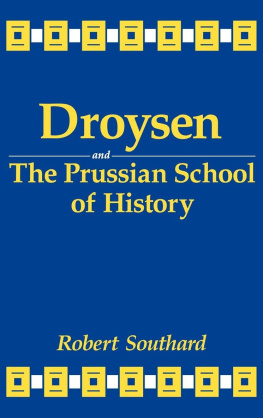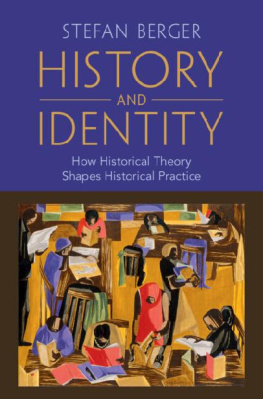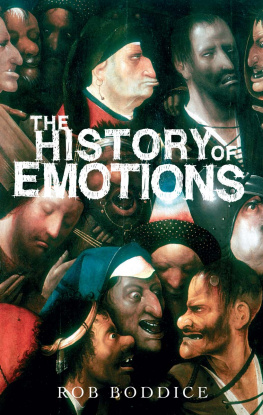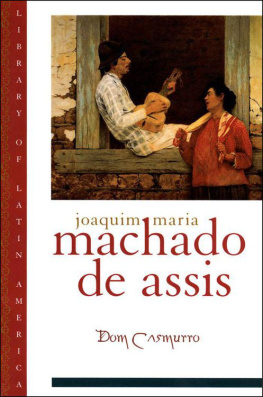
What Is History For?

MAKING SENSE OF HISTORY
Studies in Historical Cultures
General Editor: Stefan Berger
Founding Editor: Jrn Rsen
Bridging the gap between historical theory and the study of historical memory, this series crosses the boundaries between both academic disciplines and cultural, social, political and historical contexts. In an age of rapid globalization, which tends to manifest itself on an economic and political level, locating the cultural practices involved in generating its underlying historical sense is an increasingly urgent task.
For a full volume listing please see back matter
WHAT IS HISTORY FOR?
Johann Gustav Droysen and the Functions of Historiography
Arthur Alfaix Assis
First published in 2014 by
Berghahn Books
www.berghahnbooks.com
2014, 2016 Arthur Alfaix Assis
First paperback edition published in 2016
All rights reserved. Except for the quotation of short passages for the purposes of criticism and review, no part of this book may be reproduced in any form or by any means, electronic or mechanical, including photocopying, recording, or any information storage and retrieval system now known or to be invented, without written permission of the publisher.
Library of Congress Cataloguing-in-Publication Data
Assis, Arthur Alfaix.
What is history for? : Johann Gustav Droysen and the functions of historiography / Arthur Alfaix Assis.
pages cm. (Making sense of history ; Volume 17)
Includes bibliographical references and index.
ISBN 978-1-78238-248-5 (hardback) ISBN 978-1-78533-334-7 (paperback) ISBN 978-1-78238-249-2 (ebook)
1. HistoriographyPhilosophy. 2. HistoriographyPolitical aspects. 3. Droysen, Johann Gustav, 18081884. I. Title.
D16.8.A727 2014
907.2dc23
2013017832
British Library Cataloguing in Publication Data
A catalogue record for this book is available from the British Library.
ISBN: 978-1-78238-248-5 hardback
ISBN 978-1-78533-334-7 paperback
ISBN: 978-1-78238-249-2 ebook
Acknowledgements

I am indebted to a good number of people who throughout the different phases of this projects development, from its inception to the preparation of the manuscript, provided me with scholarly advice, spiritual support and friendly encouragement (and frequently all these together). They are, at least: David Aires Neto, Dermeval de Sena Aires Jr., Andr Arajo, Shadia Husseini de Arajo, Marcelo Balaban, Diana Brenscheidt, William Brito Jr., Hannah Busch, Aaron Bustamante, Maria Filomena Coelho, Vicente Dobroruka, Francisco Doratioto, Marten Dring, Kira Funke, Jean-Claude Gens, Christian Gudehus, Jos Otvio Guimares, Lus de Gusmo, Lizette Jacinto, Theo Jung, Oliver Kozlarek, Jordino Marques, Henrique Modanez de SantAnna, Srgio da Mata, Fabiano Menke, Sebastio Nascimento, Marcos Aurlio Pereira, Peter Hanns Reill, Norma Reynolds, Marlon Salomon, No Freire Sandes, Judith Schildt, Gunter Scholtz and Mrio Silva, as well as my brothers, Fred and Gustavo O. A. Assis. I am also very grateful to my former teachers Carlos Oiti Berbert Jr., Estevo de Rezende Martins, Jrn Rsen and Luiz Srgio Duarte da Silva. My option to dedicate a good part of my time to walk the fascinating field between history and theory is largely due to the great impression their classes and texts left on me.
Horst Walter Blanke, Pedro Caldas, Chen Chih-hung, Christiane Hackel, Friedrich Jaeger and Stephan Paetrow share my interest in Droysens historical theory. They imparted their expertise and knowledge at many crucial moments, and I would like them to know how much I have appreciated their advice and criticism. In the case of Horst Blanke, I am doubly thankful, since he gave me access to the text of the second volume of the critical edition of Droysens Historik almost two years before its publication.
Throughout the research and writing processes, I was associated with the Institute of Advanced Studies in the Humanities (KWI) in Essen and to Witten/Herdecke University, both in Germany, and later to the University of Braslia. I would also like to thank the organizations that all along this project provided me with funding: the Brazilian Ministry of Education, through its funding agency, CAPES; the German Academic Exchange Service (DAAD); the Stiftung Mercator, through the research project Humanism in the Era of Globalization; the Center for Seventeenth- and Eighteenth-Century Studies of the University of California, Los Angeles; Brazils National Council for Scientific and Technological Development (CNPq) and finally the History Graduate Program at the University of Braslia. At Berghahn Books I am particularly thankful to Elizabeth Berg, Adam Capitanio and Ann DeVita for their competent assistance. I am also thankful to the two anonymous peer reviewers who very much helped me in giving the text its final shape, as well as to Jaime Taber, who did an excellent job copyediting the manuscript.
I owe special thanks to my wife, Vnia Carvalho Pinto, not only for her lovely companionship but also for having helped immensely in converting the manuscript into passable academic English. Last but not least, I would like to thank my parents, Marly Oliveira Assis and Eduardo Augusto Alfaix Assis, for all the love and support they have always given me. This work is dedicated to them.
Introduction

In many cultures, the practice of historiography has often been attended by reflections on its general value and function. In the Western world since classical antiquity, some rhetoricians, philosophers and historians have attempted to explain why writing narratives referring to the past (and reading them) happens to be a worthwhile venture. Throughout the centuries a great variety of explanations emerged, most of them stressing that the issue goes far beyond the recognition that reading histories is sometimes a pleasant experience. In this regard, one explanatory topos had a very significant impact: Ciceros (10643 BC) metaphor comparing history to a magistra vitae (lifes teacher, guide to life). Up until the beginnings of modern times, very few scholars would disagree with the argument condensed in Ciceros metaphor, namely, that the historians task is to convey to an audience the lessons that can be extracted from past events and experiences. Even today, one could still easily uncover metaphors and arguments similar to Ciceros in several cultural realms. However, historians on duty at the beginning of the twenty-first century unless they wished to commit professional suicide no longer resorted to such a discourse when justifying the significance of their work and their academic discipline.








 What Is History For?
What Is History For? 




